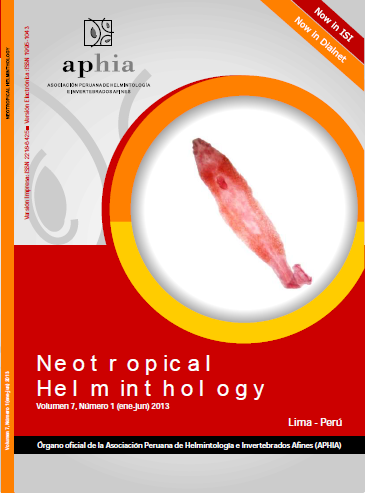PARASITE FAUNA OF PARANTHIAS COLONUS (VALENCIENNES, 1846) FROM ELSARGENTO, BAJA CALIFORNIA SUR, MEXICO
DOI:
https://doi.org/10.24039/rnh201371945Keywords:
Baja California Sur, Copepods, El Sargento, Helminths, Mexico, ParanthiasAbstract
Paranthias colonus(Valenciennes, 1846) is used as fish bait replacing first class fish that have been overfished in the Gulf of California. Due to its recent commercial importance, the parasite fauna of P. colonusfrom of El Sargento, Baja California Sur, Mexico is characterized to define its role in the life cycle of its parasites. 30 fishes were fixed in 4% formaldehyde for later examination. Helminths and copepods were treated with conventional techniques specific to each kind of parasite. P. colonushad 100% prevalence and 46.5 mean intensity of parasites. Adults of Pseudorhabdosynochus sp., Prodistomum orientalis, Brachyphallus sp., Lecithochirium sp., Spinitectus sp., Caligus sp., Pandaridae, and Hatschekia sp. and larevae of Tetragonocephalidae, Scolex pleuronectis and Anisakis sp. were found. There was evidence of host specificity of Pseudorhabdosynochussp. and Hatschekiasp. by serranid fish. P. orientalisis reported for the second time. Hemiuridae are generalists so Paranthiashas added to this host range. The presence of the metacestodes S. pleuronectisand Tetragonocephalidae indicates their role in Paranthiasas intermediate or paratenic hosts because they are found in adult elasmobranches. Anisakissp. and Caligussp. are of wide geographic distribution and host range. Anisakissp. is the only worm that poses a potential danger to public health because it causes anisakidosis. Members of the family Pandaridae are almost exclusive parasites in elasmobranchians and Paranthiasis widely spread in its hosts. This work reports the first world record of hosts and localities of the studied materials.
Downloads
Published
How to Cite
Issue
Section
License
Copyright (c) 2021 Neotropical Helminthology

This work is licensed under a Creative Commons Attribution-NonCommercial-NoDerivatives 4.0 International License.
OBJETO: El AUTOR-CEDENTE transfiere de manera TOTAL Y SIN LIMITACIÓN alguna al CESIONARIO los derechos patrimoniales que le corresponden sobre la (s) obra(s) tituladas: xxxxxxxxxxxxxxxx, por el tiempo que establezca la ley internacional. En virtud de lo anterior, se entiende que el CESIONARIO adquiere el derecho de reproducción en todas sus modalidades, incluso para inclusión audiovisual; el derecho de transformación o adaptación, comunicación pública, traducción, distribución y, en general, cualquier tipo de explotación que de las obras se pueda realizar por cualquier medio conocido o por conocer en el territorio nacional o internacional.
REMUNERACIÓN: La cesión de los derechos patrimoniales de autor que mediante este contrato se hace será a título gratuito.
CONDICIONES Y LEGITIMIDAD DE LOS DERECHOS: El AUTOR-CEDENTE garantiza que es propietario integral de los derechos de explotación de la(s) obra(s) y en consecuencia garantiza que puede contratar y transferir los derechos aquí cedidos sin ningún tipo de limitación por no tener ningún tipo de gravamen, limitación o disposición. En todo caso, responderá por cualquier reclamo que en materia de derecho de autor se pueda presentar, exonerando de cualquier responsabilidad al CESIONARIO.
LICENCIA DE ACCESO ABIERTO: El AUTOR-CEDENTE autoriza que manuscrito publicado en La Revista Neotropical Helminthology permanece disponible para su consulta pública en el sitio web https://www.neotropicalhelminthology.com/ y en los diferentes sistemas de indexación y bases de datos en las que la revista tiene visibilidad, bajo la licencia Creative Commons, en la modalidad Reconocimiento-No comercial- Sin Trabajos derivados –aprobada en Perú, y por lo tanto son de acceso abierto. De ahí que los autores dan, sin derecho a retribución económica, a la Asociación Peruana de Helmintología e Invertebrados Afines (APHIA), los derechos de autor para la edición y reproducción a través de diferentes medios de difusión.


 Numero 2 Volumen 19 - 2025 (versión Anticipada)
Numero 2 Volumen 19 - 2025 (versión Anticipada)














































